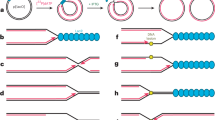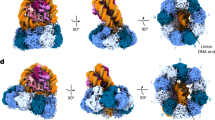Abstract
When cells are exposed to elevated temperatures, transcription of a small set of genes, the heat-shock genes, is activated1–5. This response is mediated by a short DNA sequence, the heat-shock element (HSE)5–7, which is thought to be the binding site for a specific transcription factor8–12. Studies with Drosophila show that this protein binds to HSEs only in heat-shocked cells, suggesting that changes in factor binding are responsible for gene activation10. We have investigated the properties of HSE-binding proteins from yeast and HeLa cells. In HeLa cells, binding activity is present only after heat shock. In contrast, control and heat-shocked yeast cells yield the same amount of HSE-binding activity; however, the mobility of protein-HSE complexes on polyacrylamide gels is altered following heat shock. This mobility difference can be significantly reduced by treatment of crude extracts with phosphatase. We propose that the yeast heat-shock factor binds constitutively to DNA but only activates transcription after heat-induced phosphorylation.
This is a preview of subscription content, access via your institution
Access options
Subscribe to this journal
Receive 51 print issues and online access
$199.00 per year
only $3.90 per issue
Buy this article
- Purchase on Springer Link
- Instant access to full article PDF
Prices may be subject to local taxes which are calculated during checkout
Similar content being viewed by others
References
Nover, L. (ed.) Heat shock response of eukaryotic cells (Springer, Berlin, 1984).
Craig, E. A. CRC Crit. Rev. Biochem. 18, 239–280 (1985).
Lindquist, S. A. Rev. Biochem. 55, 1151–1191 (1986).
Pelham, H. R. B. Trends Genet. 1, 31–35 (1985).
Bienz, M. & Pelham, H. R. B. in Advances in Genetics (in the press).
Pelham, H. R. B. Cell 30, 517–528 (1982).
Pelham, H. R. B. & Bienz, M. EMBO J. 1, 1473–1477 (1982).
Parker, C. S. & Topol, J. Cell 37, 273–283 (1984).
Wiederrecht, G., Shuey, D. J., Kibbe, W. A. & Parker, C. S. Cell 48, 507–515 (1987).
Wu, C. Nature 309, 229–234 (1984).
Wu, C. Nature 311, 81–84 (1984).
Sorger, P. K. & Pelham, H. R. B. EMBO J. (in the press).
Berger, E. M., Torrey, D. & Morganelli, C. Somat. Cell molec. Genet. 12, 433–440 (1986).
Fried, M. & Crothers, D. M. Nucleic Acids Res. 9, 6505–6525 (1981).
Garner, M. M. & Revzin, A. Nucleic Acids Res. 9, 3047–3060 (1981).
Kingston, R. E., Schuetz, T. J. & Larin, Z. Molec. cell. Biol. 7, 1530–1534 (1987).
Slater, M. R. & Craig, E. A. Molec. cell. Biol. 7, 1906–1916 (1987).
Sen, R. & Baltimore, D. Cell 47, 921–928 (1986).
Seguin, C. & Hamer, D. H. Science 235, 1383–1387 (1987).
Treisman, R. Cell 46, 567–574 (1986).
Gilman, M. Z., Wilson, R. N. & Weinberg, R. A. Molec. cell. Biol. 6, 4305–4316 (1986).
Dignam, J. D., Lebowitz, R. M. & Roeder, R. G. Nucleic. Acids Res. 11, 1475–1489 (1983).
Breeden, L. & Nasmyth, K. Cell 48, 389–397 (1987).
Guarente, L. & Mason, T. Cell 32, 1279–1286 (1983).
Author information
Authors and Affiliations
Rights and permissions
About this article
Cite this article
Sorger, P., Lewis, M. & Pelham, H. Heat shock factor is regulated differently in yeast and HeLa cells. Nature 329, 81–84 (1987). https://doi.org/10.1038/329081a0
Received:
Accepted:
Issue Date:
DOI: https://doi.org/10.1038/329081a0
This article is cited by
-
Differential expression and regulation of HSP70 gene during growth phase in ruminants in response to heat stress
Scientific Reports (2022)
-
Hsf1 and Hsp90 orchestrate temperature-dependent global transcriptional remodelling and chromatin architecture in Candida albicans
Nature Communications (2016)
-
Fungal Hsp90: a biological transistor that tunes cellular outputs to thermal inputs
Nature Reviews Microbiology (2012)
-
Heat shock response relieves ER stress
The EMBO Journal (2008)
Comments
By submitting a comment you agree to abide by our Terms and Community Guidelines. If you find something abusive or that does not comply with our terms or guidelines please flag it as inappropriate.



